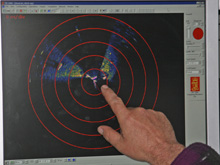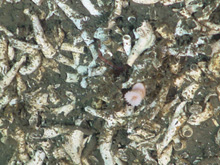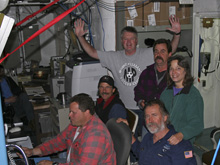Monitor screen from the ROV sonar showing a red target area, indicating a large hard object. When investigated, it was mapped as a monolithic boulder rising over 25 feet off the seafloor. Click image for larger view and image credit.
Monolith and Lophelia
May 29, 2006
Ed Bowlby
Olympic Coast National Marine Sanctuary
The night crew had been surveying a relatively flat seafloor with occasional rocks for almost seven hours when I noticed a large red target on the pilot’s sonar screen. The ROV pilot confirmed that this was a large isolated hard object rising a considerable height off the seafloor. Although our transect line would not have taken us across the target, our goal was to locate hard substrate with the assumption that it would provide potential coral habitat. I made the call that this would be worth investigating, announcing to the other scientists and ROV technicians that we would be break our transect-line to visit it. And boy, was it worth it. As we got closer, the lights of the ROV revealed a vertical wall face. Excitement rose in the control room. At the base of the wall was a white mound of coral rubble that we later confirmed as Lophelia pertusa. However, we first wanted to explore and map this towering wall, so we could return later. We slowly ascended up the wall, like riding an elevator mere feet away from a towering cliff, then across the top and down the other side. We repeated the up and over and down maneuver several times as we spent the next five hours examining this huge, house-sized boulder, we dubbed “the monolith,” which towered over 25 feet off the seafloor. Varied species of invertebrates, including soft corals and crinoids, encrusted its surfaces and many rockfish hovered nearby. And yes, we not only confirmed that the rubble mound was Lophelia, with a few live polyps, but at the base of the wall above the rubble were several patches of live Lophelia. This was our first sighting of this hard coral on the cruise, the species that we had first documented off the Washington coast in 2004. Word quickly circulated around the ship and the other co-Principal Investigators from the earlier shift, Mary Sue and Jeff, jubilantly joined us. We had confirmed another location of this rare hard coral in the Northeast Pacific, a deep water reef-building species more commonly found in the North Atlantic.
Sign up for the Ocean Explorer E-mail Update List.
















